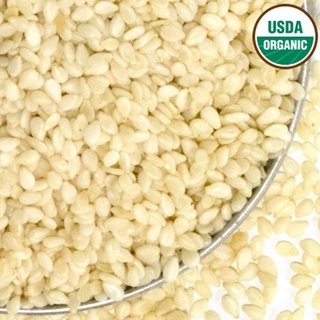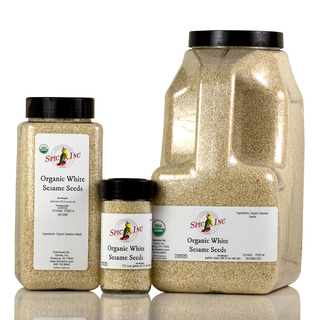Organic White Sesame Seed




Organic White Sesame Seed
Sesame seeds are just a small part of the history of food in the world, but they are by no means unimportant. Full of flavor and oil that has long been an essential tool for human life, these tiny seeds are scientifically called Sesamum indicum. The name sesame comes from a Greek word, "sesamon," and the sesame seed is a star ingredient in several global cuisines including Middle Eastern, Asian, African, and Mediterranean.
While there are no volatile oils in sesame seeds, they are made up of 45-65% fixed oil predominantly made up of olein.
Sesame is called "juljulan" by speakers of Arabic, "zi mah" to those who use Mandarin, "till" in French, "sesam" by German speakers, "gingili" or "til" in the Hindi language, "goma" in Japanese, "gergelim" to speakers of Portuguese, "kunzhut" in Russian, and finally "ajonjoli" in Spanish.
History of White Sesame Seeds
Sesame seeds were one of the first condiments and one of the first plants to be used for edible oil. Of the historical records we have of white sesame seeds, those of the Assyrian people are of the first written records. They had tablets where they recorded stories, of which was one about how their gods drank sesame wine the night before they created the earth.
In Egypt, sesame seed is mentioned on the Ebers papyrus, a scroll of 65 feet in length that described ancient herbs and spices. It's considered one of the earliest medical texts, dated about 1550 BCE, with roughly 700 proposed remedies for afflictions like crocodile bites and ingrown toenail pain. There are also some mixtures listed to help rid your home of pests like insects, scorpions, and rats. Sesame oil was also one of the oils used to power Egyptian lamps, as evidence from several archeological sites shows.
In Hindu tradition, the sesame seed represents immortality. Women of ancient Babylon would mix honey and sesame seeds together to stave off the aging process and give their bodies more strength. They would also use sesame oils to create perfumes and medicines. The ancient Greeks and Romans believed the seed would give them strength to conquer new lands and territories.
Sesame seed was introduced to Europe in the first century, and in the 17th century it was introduced to the United States when African slaves brought their foods and traditions to them to the states during their forced relocation.
Organic White Sesame Seed Cultivation
The sesame plant is able to survive in several types of soils, but they prefer well-drained, organic material rich, pH neutral soil. It thrives in the climates found in India, China, Korea, Egypt, and East Africa. The plant is drought tolerant because of its extensive root system, and it will recognize warmer environments and extend its roots to suit that environment better before it will sprout. Seeds grow inside seed pods called "buns." The buns will burst when the seeds are fully ripe. Farmers tend to cut the buns from the plant before they are fully ripe because the pods tend to burst forth with enough force to spread the seeds out all over the place. This is good for the future of the plant, not so great for farmers who want to sell the seeds. When stored upright and allowed to finish ripening in a controlled environment, the seeds can be caught once the pods erupt. Sesame takes only 90 to 120 days to fully ripen, and the buns will shift from a green color to a yellowish-brown color when they are ripe. The plants may grow up to six feet tall.
Where is it From?
Our Organic White Sesame Seeds are grown in India.
Types of Sesame Seed
Despite the fact that sesame seeds all come from the same type of plant, their color is determined by both the environment they grew in and also the variety of that type of plant that they grow on. Seeds are categorized by colors. Black, brown, red, and white sesame seeds are the four distinct colors, but the lighter colored seeds are used most often in Western and Middle Eastern cuisines while the darker colors are more likely to be found in Asian cuisines.
Cooking with Organic White Sesame Seed
Popular in baking, sesame seeds are great for buns, bagels, or breads of all types. You can used them in honey, sauces, and dips to add a bit of nutty crunch to whatever you're making. Sesame seeds are also incredible in savory spice blends, like Organic Everything Bagel Seasoning. In Japan, sesame is an essential ingredient in the rice topping blend called Furikake.
A simple snack can be made with just three ingredients: your favorite dough, some honey, and some sesame seeds. This recipe is individual and made to whatever scale you want, so there are no exact measurements. Simply break your dough into small pieces, roll the pieces up and place on a baking tray or a baking pan. Bake at 350 until the balls begin to brown. While they are baking, make a mixture of honey and sesame seeds at whatever ratio you prefer. Add a lot of seeds if you love them, add only a few if you don't want your chewy dough balls to be as crunchy. Remove the balls from the oven and drizzle your honey and sesame seed mixture over them to taste. Enjoy the sweet, nutty flavor and the chewy texture of the dough balls! In a similar vein, Armernian Simit Cookies require a spattering of sesame seeds both for aesthetic and flavor.
If you enjoy making your own tahini, you can make it with these seeds. Tahini can then be used in homemade hummus recipes, whether they are sweet or savory. Tahini can also be used as a fruit and vegetable dip or as a spread on pita bread.
Sesame seeds need to be stored in a cool, dry place. They go rancid quickly if they are exposed to humidity or moisture in any way. Sesame oil on the other hand is very hearty and is ideal for cooking in warm to hot climates.
What Does Organic White Sesame Seed Taste Like?
Organic White Sesame Seeds are slightly nutty and have a nice, firm crunch when they are bitten into.
Substitutions and Conversions
You can use any sesame seed in place of white sesame seeds, with the only caveat being that Black Sesame Seeds are slightly more nutty than the lightly colored white seeds or toasted seeds.
Read More
The Best Fruit and Vegetable Seasonings
Spices and Seasonings of Japan
Indian Spices and Seasonings
Nutrition Facts
Serving Size1 tsp
Amount Per Serving
Calories15
% Daily Value*
Total Fat1g2%
Saturated Fat0g1%
Trans Fat0g
Polyunsaturated Fat1g
Monounsaturated Fat0g
Cholesterol0mg0%
Sodium0.3mg0%
Total Carbohydrate0.7g0%
Dietary Fiber0.4g2%
Total Sugars0.0g
Added Sugars0g0%
Sugar Alcohol0.0g
Protein0.5g1%
Vitamin D0mcg0%
Calcium27mg2%
Iron0mg2%
Potassium13mg0%
*The % Daily Value (DV) tells you how much a nutrient in a serving of food contributes to a daily diet. 2,000 calories a day is used for general nutrition advice. These values were calculated and therefore are approximate. For more accuracy, testing is advised.
